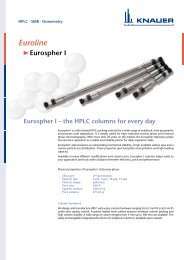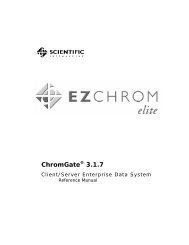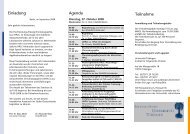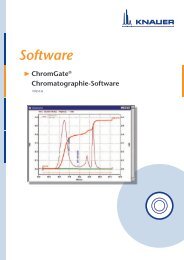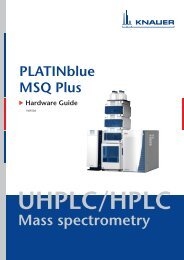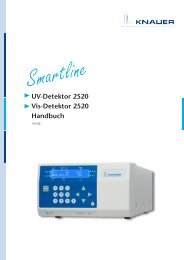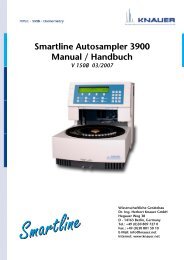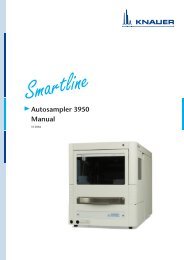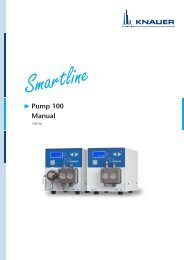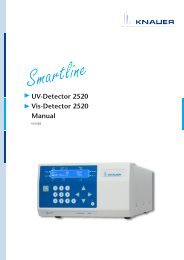Columns: Euroline care and use
Columns: Euroline care and use
Columns: Euroline care and use
- TAGS
- euroline
- www.knauer.net
You also want an ePaper? Increase the reach of your titles
YUMPU automatically turns print PDFs into web optimized ePapers that Google loves.
In gradient elution, they ca<strong>use</strong> so-called "ghost peaks". "Ghost peaks" are peaks that<br />
always appear at the same position in the chromatogram. Their origin is not the<br />
sample, but the impurities from the solvents or solvent additives. Therefore, it is highly<br />
recommended to run a gradient without injecting a sample at the beginning of each<br />
method to determine if ghost peaks will be a problem. To avoid irreversible<br />
adsorption at the head of the column, you should always <strong>use</strong> a precolumn. The <strong>use</strong> of<br />
a precolumn increases the lifetime of a column dramatically. In addition to that, a<br />
precolumn can filter particulate material coming from pump seals or injection rotors.<br />
An alternative to a precolumn is an in-line filter. These filters are placed between the<br />
column <strong>and</strong> the injector <strong>and</strong> newer versions can be mounted directly on columns.<br />
These filters are great for removing particulate material from the eluent, but they will<br />
not take the place of precolumns by removing organic impurities that may irreversibly<br />
adsorb to the column.<br />
Proper storage of silica based HPLC columns<br />
• For short-term storage, i.e. overnight, columns can be stored in the eluent.<br />
Equilibration time<br />
• For middle term storage, i.e. 2 days or over the weekend, columns should be<br />
flushed with pure water to prevent algal growth.<br />
• For long term storage, silica based columns should be stored in an aprotic<br />
solvent. The water content should not be greater than 50%. The best solvent for<br />
storage is acetonitrile.<br />
• Caution! Make sure that all buffers are washed out of the column before<br />
exchanging aqueous mobile phases by organic solvents. Buffer salts are not<br />
soluble in acetonitrile <strong>and</strong> can block capillary tubing <strong>and</strong> the column.<br />
The equilibration time of a column depends on the column dimensions. In general, a<br />
column is equilibrated after 20 column volumes are flushed through it. The<br />
equilibration times for the most important column dimensions are summarized in the<br />
following table.<br />
You can reduce the equilibration time by simply increasing the flow rate. However,<br />
make sure to flush the column with at least 20 column volumes to make sure the<br />
column is equilibrated.<br />
Column Dimension Column Volume Flow Rate Equilibration Time<br />
[ml] [ml/min] [min]<br />
250 x 4.6 mm 2.91 1.00 58<br />
150 x 4.6 mm 1.74 1.00 35<br />
100 x 4.6 mm 1.16 1.00 23<br />
50 x 4.6 mm 0.58 1.00 12<br />
250 x 4.0 mm 2.20 1.00 44<br />
125 x 4.0 mm 1.10 1.00 22<br />
250 x 2.0 mm 0.55 0.25 44<br />
150 x 2.0 mm 0.33 0.25 26<br />
50 x 2.0 mm 0.11 0.25 9<br />
Regeneration of a column<br />
Impurities from the sample or mobile phase can adsorb to the head of a column <strong>and</strong><br />
ca<strong>use</strong> changes in selectivity or peak splitting. Often these "dirty columns" can be<br />
regenerated by applying the following protocols:





